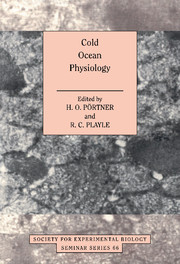Preface
Published online by Cambridge University Press: 13 March 2010
Summary
The last two decades have seen a drastic increase in our knowledge of adaptational mechanisms in cold ocean environments. General hypotheses have been developed addressing the potentials and limitations of life under these conditions which from an anthropocentric understanding have always been seen as harsh and demanding. Some of the early hypotheses have recently been questioned. For example, the concept of metabolic cold adaptation, which postulated a rise in energy expenditure to compensate for the thermodynamic effect of low temperature is currently being modified by several laboratories and the mechanistic and molecular background of changes in metabolic rate is being studied. The volume reviews both the general concepts and the detailed mechanisms of adaptation. Presentations cover a wide range of topics on cold ocean physiology, from molecular to whole animal, including invertebrates, fish, marine mammals, and birds.
The volume opens with a general outline of animal physiology in the cold addressing the physical challenges and physiological constraints that exposure to low temperature may imply (A. Clarke). Mechanisms of cold compensation are briefly summarised, setting the stage for the following, more detailed treatments. The general conclusion of this overview is that constraints in the physiological design required in the cold may preclude lifestyles requiring high rates of aerobic power output. The following papers describe the compensatory mechanisms in detail which would enable marine ectotherms to thrive in the cold. Differentiation between polar and deep-sea environments is required, since an investigation of cold adaptation in deepsea organisms requires the consideration of depth-related variables like hydrostatic pressure, light intensity and oxygen levels.
- Type
- Chapter
- Information
- Cold Ocean Physiology , pp. xiv - xviiiPublisher: Cambridge University PressPrint publication year: 1998

